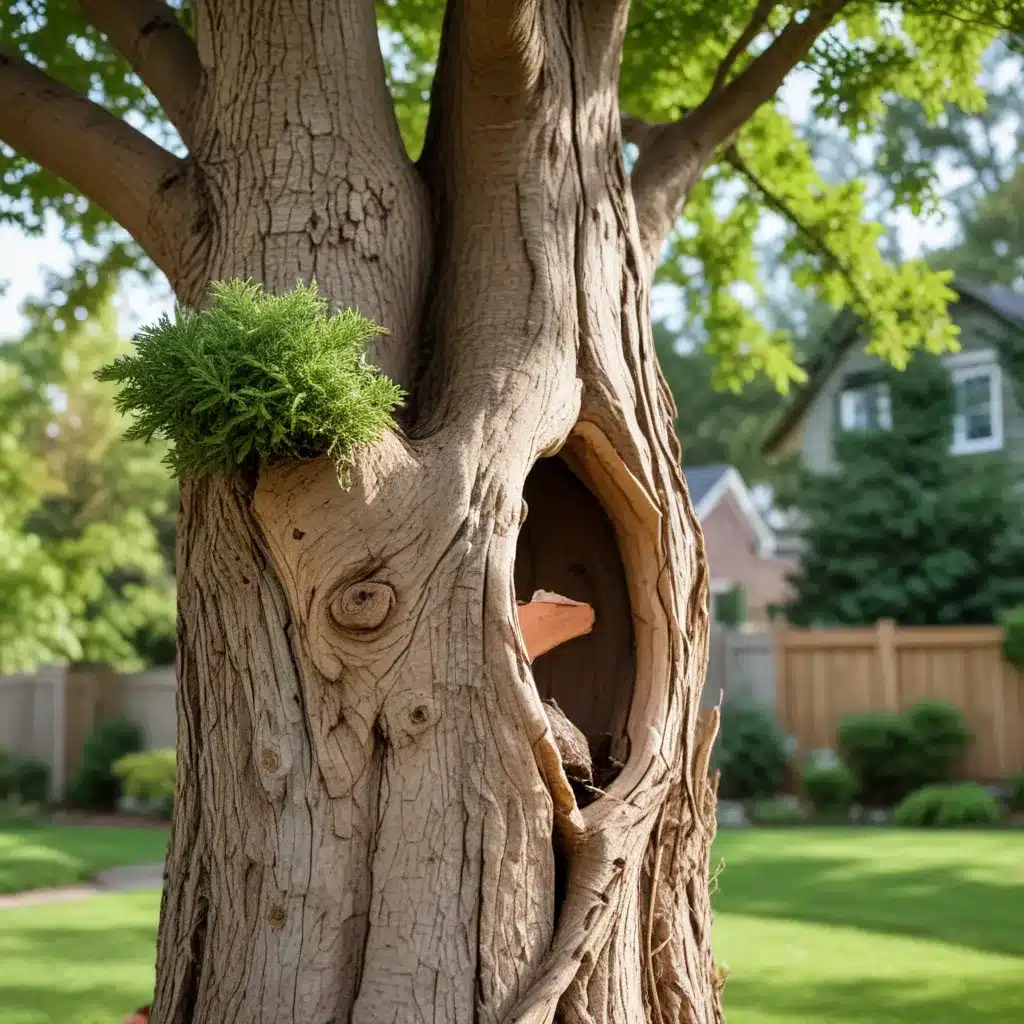
Embracing the Art of Tree Shaping and Sculpting: DIY Techniques for Curb Appeal
The art of tree shaping and sculpting holds a profound, centuries-old legacy, with techniques ranging from the ornate topiaries of Europe to the minimalist bonsai of Japan. As a tree care specialist, I’ve witnessed firsthand the remarkable transformations that can occur when horticulture and artistic vision converge. By understanding the nuances of plant biology and leveraging strategic pruning methods, homeowners can cultivate stunning, personalized landscapes that elevate their property’s curb appeal.
Tree Shaping Techniques
Topiary Artistry
The meticulously trimmed and shaped hedges, shrubs, and trees of traditional topiary gardens evoke a sense of refined elegance. This labor-intensive practice involves regularly pruning plant material into geometric forms, whimsical animal silhouettes, or intricate patterns. While requiring significant maintenance, topiary offers homeowners a chance to showcase their horticultural expertise and design sensibilities. By selecting hardy, densely foliated species like boxwood, yew, or privet, DIY enthusiasts can create captivating focal points that draw the eye and establish a formal, manicured aesthetic.
Espalier Designs
An alternative shaping technique, espalier, trains tree branches to grow in a two-dimensional, often symmetrical fashion against a trellis or wire framework. This method not only creates visually striking compositions but also maximizes limited garden space by producing fruit or flowers along a flattened plane. Pear, apple, and citrus trees lend themselves particularly well to espalier applications, with homeowners carefully manipulating the growth to achieve desired linear patterns. Patience is essential, as espalier requires years of diligent pruning and branch positioning to achieve the intended form.
Bonsai Cultivation
The ancient Japanese art of bonsai challenges gardeners to cultivate miniaturized, artfully sculpted trees within shallow containers. By restricting root systems and meticulously trimming foliage, bonsai practitioners create the illusion of mature, aged specimens in diminutive scales. While requiring specialized techniques and an unwavering commitment, bonsai allows DIY enthusiasts to incorporate living, organic sculptures into their landscape designs. Selecting the appropriate species, from Japanese maples to Chinese elms, and mastering pruning rhythms are crucial to the success of any bonsai project.
Tree Sculpting Methods
Pruning Strategies
At the heart of tree shaping and sculpting lies the art of pruning. Skilled arborists strategically remove select branches, stems, and foliage to guide a plant’s growth, promote structural integrity, and enhance aesthetic appeal. From thinning out crowded interiors to shaping terminal buds, each pruning cut must be made with precision and an understanding of a tree’s natural growth habits. DIY enthusiasts should familiarize themselves with proper techniques, such as the three-cut method and angle of removal, to minimize damage and ensure the long-term health of their specimens.
Grafting Approaches
The process of grafting allows gardeners to combine disparate tree varieties, creating visually captivating hybrids. By carefully joining the cambium layers of compatible rootstock and scion wood, DIY enthusiasts can experiment with unique color palettes, unusual fruit production, or novel growth patterns. Mastering grafting techniques, such as cleft, bark, or approach grafting, requires patience and a keen eye, but the results can be both horticulturally and artistically rewarding.
Structural Support Systems
To maintain the structural integrity of their sculpted trees, homeowners may need to implement support systems, such as bracing, cabling, or guying. These methods help distribute the weight of heavy limbs, prevent storm damage, and ensure the longevity of the desired form. Understanding the appropriate applications for each support system, as well as proper installation techniques, is crucial to avoiding inadvertent harm to the tree.
Landscaping for Curb Appeal
Enhancing Home Exteriors
The strategic placement and shaping of trees can dramatically enhance a home’s curb appeal, creating a cohesive, visually striking landscape. By positioning focal point trees along the entryway, framing architectural features, or softening hard edges, homeowners can establish a welcoming, harmonious aesthetic. Carefully considering a tree’s mature size, branching habit, and seasonal interest when selecting and siting specimens is essential for achieving the desired visual impact.
Sustainable Gardening
Homeowners seeking to create eco-friendly, low-maintenance landscapes can incorporate native tree species into their shaping and sculpting endeavors. Indigenous flora, adapted to local climate conditions, often require less water, pesticides, and ongoing care than non-native cultivars. Additionally, by selecting drought-tolerant, water-wise species, DIY enthusiasts can reduce their environmental footprint while still enjoying the visual benefits of a beautifully sculpted landscape.
The Art of Tree Transformation
Creative Visioning
Approaching tree shaping and sculpting as an artistic medium, DIY enthusiasts can unleash their creative potential, transforming ordinary specimens into extraordinary living sculptures. By sketching conceptual designs, exploring inspirational references, and experimenting with different techniques, homeowners can develop a unique visual language that reflects their personal aesthetic preferences and the character of their property.
Horticultural Expertise
Successful tree transformation, however, requires a deep understanding of plant biology and growth patterns. Mastering pruning methods, graft compatibility, and structural support systems allows DIY enthusiasts to confidently manipulate their trees, ensuring the long-term health and structural integrity of their sculpted masterpieces.
DIY Opportunities
Project Planning
For homeowners eager to embark on their own tree shaping and sculpting adventures, careful project planning is crucial. Considerations such as budgeting, selecting appropriate tools, and establishing a realistic timeline can help ensure a smooth and successful DIY experience. Consulting with a local arborist or horticulturist can also provide valuable insights and guidance throughout the process.
Step-by-Step Guidance
Numerous online tutorials, instructional videos, and how-to guides are available to walk DIY enthusiasts through the various techniques of tree shaping and sculpting. From pruning demonstrations to grafting walkthroughs, these resources can help homeowners develop the necessary skills and safety precautions to transform their landscapes with confidence.
By embracing the art of tree shaping and sculpting, homeowners can elevate their property’s curb appeal, cultivate sustainable landscapes, and express their creative vision through the living, breathing medium of plants. With a solid foundation in horticultural knowledge and a willingness to experiment, DIY enthusiasts can unlock the transformative potential of their trees and craft captivating, personalized outdoor spaces. For more information and professional guidance, visit TriCounty Tree Care.


